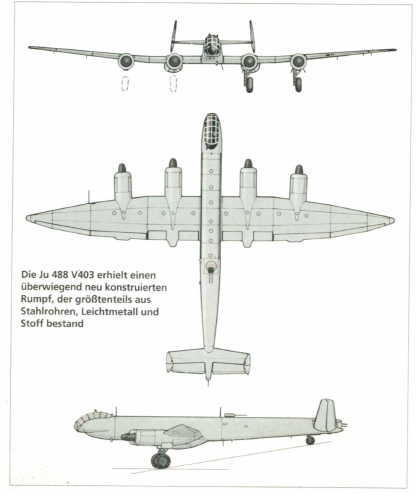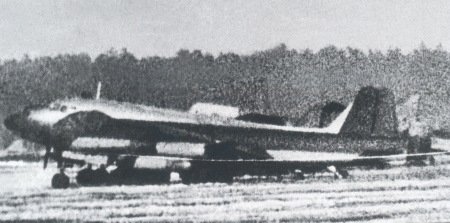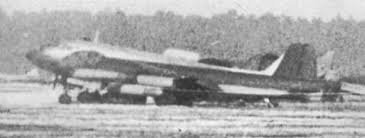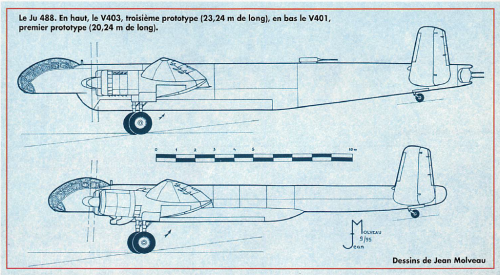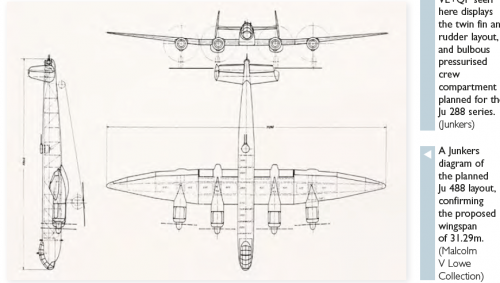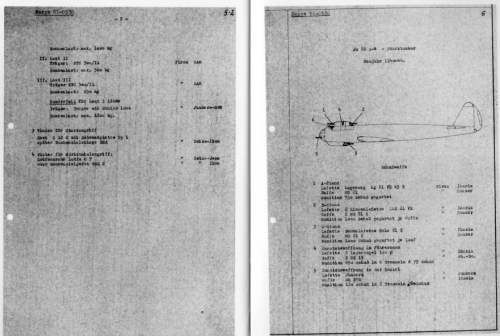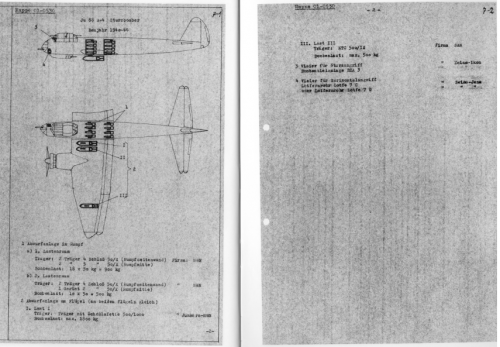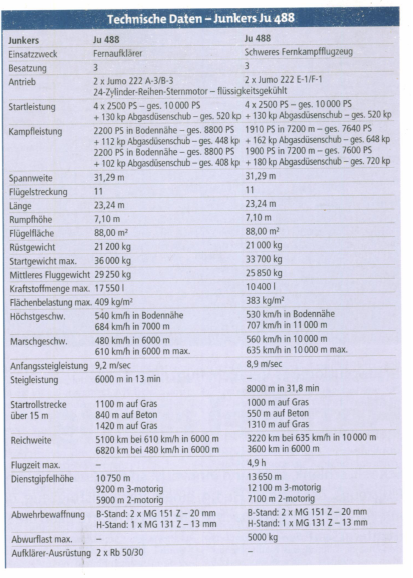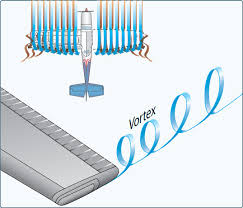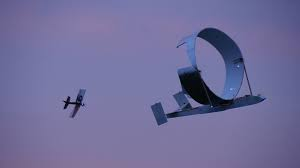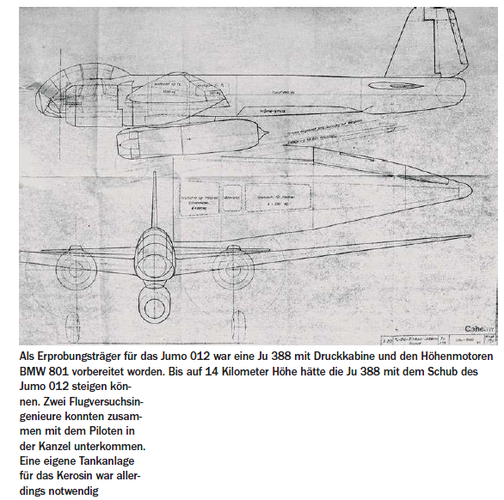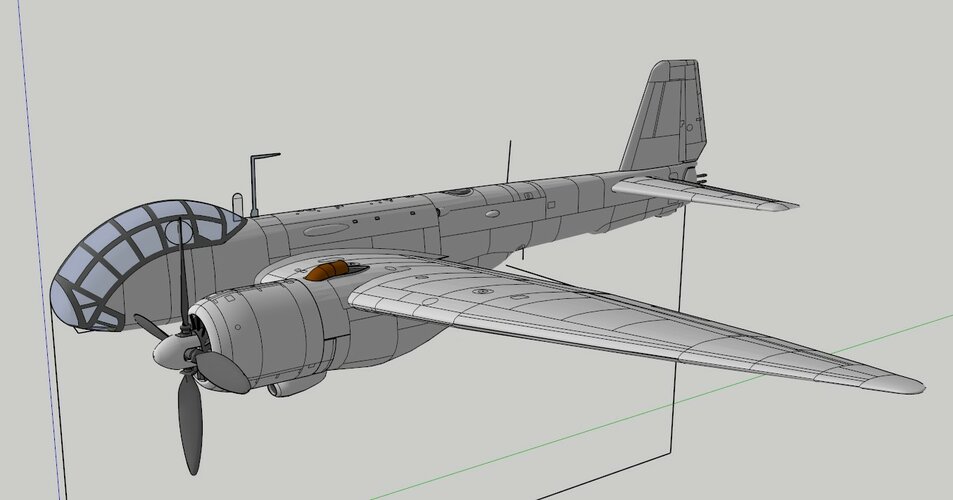You are using an out of date browser. It may not display this or other websites correctly.
You should upgrade or use an alternative browser.
You should upgrade or use an alternative browser.
Junkers Ju 85/88/188/388 & 488 - Projects, Prototypes and Variants
- Thread starter hesham
- Start date
blackkite
Don't laugh, don't cry, don't even curse, but.....
- Joined
- 31 May 2007
- Messages
- 8,819
- Reaction score
- 7,716
Re: Junkers Projects and Prototypes of WW II
Hi!
Junkers Ju 488 V-401, V-402 and V-403 drawings.
No.2 drawing is named V-403, but perhaps it's a mistake.
Or No.1 picture shows V-402 and No.2 picture shows V-401. I'm not sure. Please someone teach me.
luft46 seems to say that No.2 drawing shows V-401.
No defensive armament was to be fitted to either the V401 or V402. Fuselage tail end shape of No.1 drawing and No.2 drawing is different.
I imagine that V-403 outside undercarriages are drop undercarriage, because outside engine nacell size are to small to retract undercarriage. Please confirm No.1 drawing, especially engine nacelle.
Or outside undercarriage were twisted 90 degree and retracted? Wing trailing edge shape shows this mechanism? Any way inside engine nacelle is very large. Why? This size could retract double tire?
Perhaps Junkers used thin wing for high speed, so support for outer engine was needed on the ground.German engineers loved high speed very much ;D
V-401 MODEL.
V-401 and V-402 had turbocharged BMW801TJ aircooling radial engine. You can see turbocharger and intercooler in 801TJ pictures.
We can see BMW801TJ's ram air intake for turbocharger in the bottom picture. But I can't find this intake in three side view drawing.???
Hi!
Junkers Ju 488 V-401, V-402 and V-403 drawings.
No.2 drawing is named V-403, but perhaps it's a mistake.
Or No.1 picture shows V-402 and No.2 picture shows V-401. I'm not sure. Please someone teach me.
luft46 seems to say that No.2 drawing shows V-401.
No defensive armament was to be fitted to either the V401 or V402. Fuselage tail end shape of No.1 drawing and No.2 drawing is different.
I imagine that V-403 outside undercarriages are drop undercarriage, because outside engine nacell size are to small to retract undercarriage. Please confirm No.1 drawing, especially engine nacelle.
Or outside undercarriage were twisted 90 degree and retracted? Wing trailing edge shape shows this mechanism? Any way inside engine nacelle is very large. Why? This size could retract double tire?
Perhaps Junkers used thin wing for high speed, so support for outer engine was needed on the ground.German engineers loved high speed very much ;D
V-401 MODEL.
V-401 and V-402 had turbocharged BMW801TJ aircooling radial engine. You can see turbocharger and intercooler in 801TJ pictures.
We can see BMW801TJ's ram air intake for turbocharger in the bottom picture. But I can't find this intake in three side view drawing.???
Attachments
-
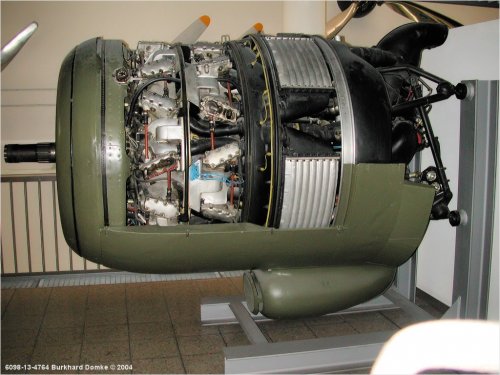 BMW801TJ_6098.jpg321.3 KB · Views: 470
BMW801TJ_6098.jpg321.3 KB · Views: 470 -
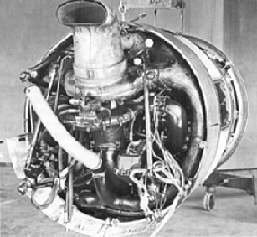 bmw_tj.jpg12.7 KB · Views: 1,033
bmw_tj.jpg12.7 KB · Views: 1,033 -
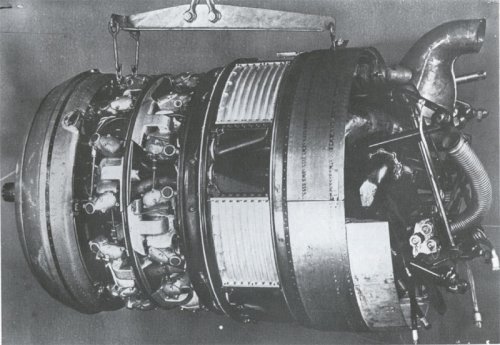 bmw801tj.jpg101.1 KB · Views: 320
bmw801tj.jpg101.1 KB · Views: 320 -
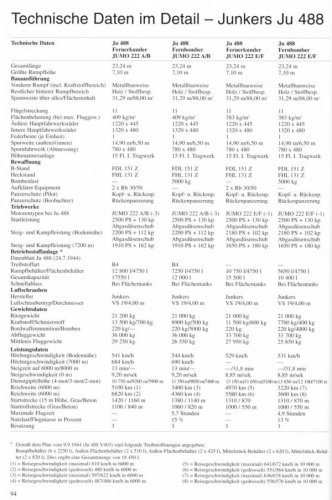 094-600x905.jpg93.8 KB · Views: 422
094-600x905.jpg93.8 KB · Views: 422 -
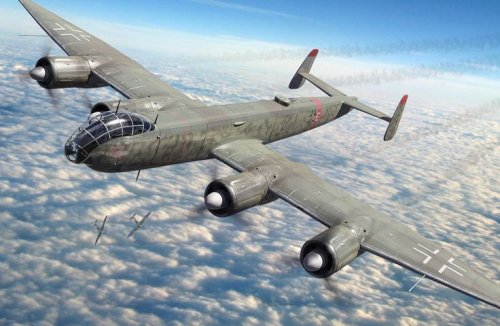 V-403.jpg64.2 KB · Views: 424
V-403.jpg64.2 KB · Views: 424 -
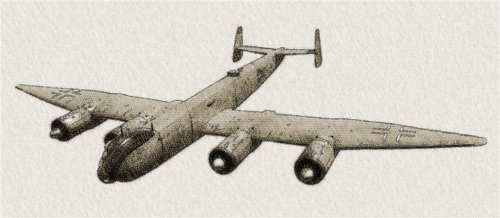 Junkers_Ju_488_V-403.jpg127.5 KB · Views: 419
Junkers_Ju_488_V-403.jpg127.5 KB · Views: 419 -
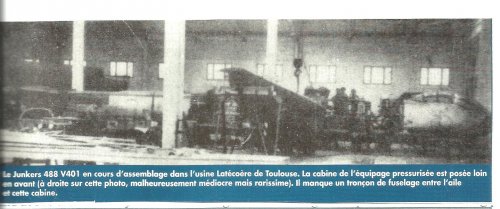 V-401.jpg238.2 KB · Views: 459
V-401.jpg238.2 KB · Views: 459 -
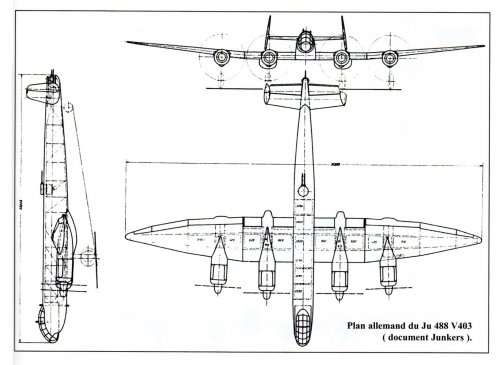 Ju 488 V-403.jpg297.3 KB · Views: 494
Ju 488 V-403.jpg297.3 KB · Views: 494 -
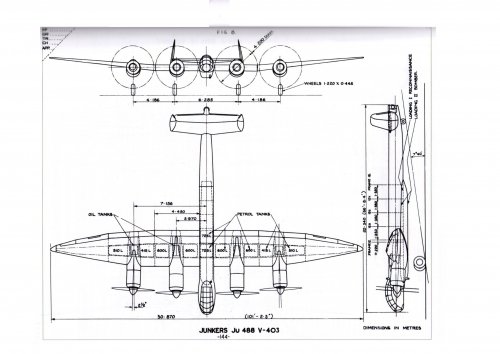 Ju 488 V-402.jpg464.6 KB · Views: 489
Ju 488 V-402.jpg464.6 KB · Views: 489 -
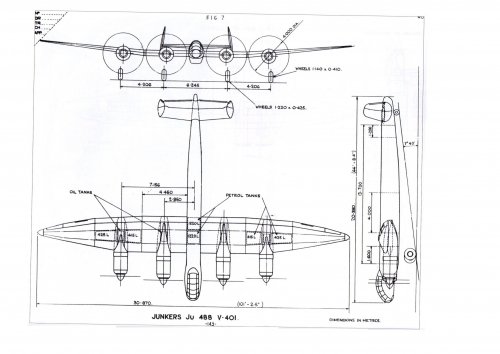 Ju 488 V-401.jpg439.4 KB · Views: 565
Ju 488 V-401.jpg439.4 KB · Views: 565
Last edited:
Vladimir
I really should change my personal text
- Joined
- 22 September 2015
- Messages
- 321
- Reaction score
- 53
hesham said:Hi,
A really picture to Junkers EF-131 six engined jet bomber,and a drawing to
Ju-488.
Yes, photo of the rough quality... But it seemd to be unique... Colour shema and markings should be like this:
Attachments
http://www.modellversium.de/galerie/9-flugzeuge-ww2/11398-junkers-ju-85-b-zvezda.html
i have found this site where they speak about Junkers 85 B
Well we know that their was projected with db 600 with 950 HP.
i have found this site where they speak about Junkers 85 B
Well we know that their was projected with db 600 with 950 HP.
- Joined
- 26 May 2006
- Messages
- 34,897
- Reaction score
- 15,759
someone has something on the ju 88 A4 with Wgr 21 from the book "junkersflugzeuge 1933/1945"?
My dear Sgeorges,
you meant those.
Attachments
sgeorges4
I really should change my personal text
- Joined
- 8 October 2017
- Messages
- 665
- Reaction score
- 334
I'm talking about the one page 72 and anything regarding the operationnal use of the ju 88 reaktive Bewaffnung page 71 (the Bemerkung say: Der Einbau der reaktiven Bewaffnung wurde nur von der Truppe durchgeführt),their is also a junkers 88 mit Rückwürtsbewaffnung page 65,operationnal use? interesting project regarding a ju 88 mit Sonderwaffenanlage (page 66) and ju 88 - sondereinbau page 67 (a different gondola)Great book by the way.
- Joined
- 3 June 2006
- Messages
- 3,094
- Reaction score
- 3,963
I have only seen a picture of a Junkers Ju 88 as a flying test bed, one fitted with the Junkers Jumo 004 under the port wing.
Link: http://tanks45.tripod.com/Jets45/Histories/Ju88/ju88.htm?newwindow=true
Edit:
My chrome browser notifies me, that this website isn't safe, so for Hesham, I saved this website as the attached pdf-file.
Link: http://tanks45.tripod.com/Jets45/Histories/Ju88/ju88.htm?newwindow=true
Edit:
My chrome browser notifies me, that this website isn't safe, so for Hesham, I saved this website as the attached pdf-file.
Attachments
Last edited:
Airborne2001
ACCESS: Secret
- Joined
- 19 June 2020
- Messages
- 224
- Reaction score
- 278
I simply love the Ju-388. It combines the sleek look of the Ju-188 with performance similar to the Ju-288.

Now this next thing is according to Wikipedia, so I am not sure how accurate it is. In regards to all variants, the subtype numbers indicated what engine would be used:
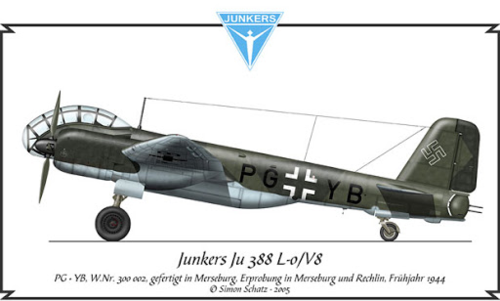
Now this next thing is according to Wikipedia, so I am not sure how accurate it is. In regards to all variants, the subtype numbers indicated what engine would be used:
- -1 = BMW 801J
- -2 = Jumo 222A/B or Jumo 222E/F
- -3 = Jumo 213E (Supercharged)
- Joined
- 26 May 2006
- Messages
- 34,897
- Reaction score
- 15,759
I have only seen a picture of a Junkers Ju 88 as a flying test bed, one fitted with the Junkers Jumo 004 under the port wing.
Link: http://tanks45.tripod.com/Jets45/Histories/Ju88/ju88.htm?newwindow=true
The link is not working my dear Rolf ?.
- Joined
- 25 July 2007
- Messages
- 4,299
- Reaction score
- 4,196
The link is not working my dear Rolf ?.
http://tanks45.tripod.com/Jets45/Histories/Ju88/ju88.htm
(Edit: " My dears,the link is still un-worked ?." Just checked again ... works just fine for me.)
Last edited:
- Joined
- 26 May 2006
- Messages
- 34,897
- Reaction score
- 15,759
My dears,the link is still un-worked ?.
I simply love the Ju-388. It combines the sleek look of the Ju-188 with performance similar to the Ju-288.
View attachment 638345
Now this next thing is according to Wikipedia, so I am not sure how accurate it is. In regards to all variants, the subtype numbers indicated what engine would be used:
Can anyone please confirm this?
- -1 = BMW 801J
- -2 = Jumo 222A/B or Jumo 222E/F
- -3 = Jumo 213E (Supercharged)
If you like the Ju388, you simply must get this book:
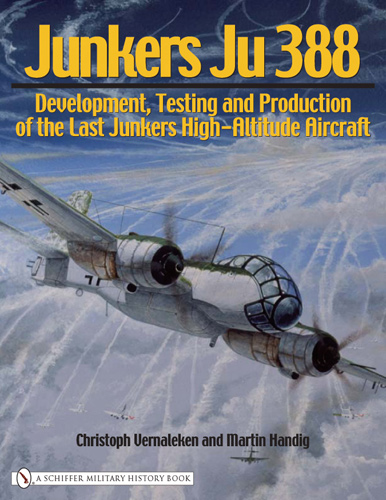
This is also a very useful website: https://www.ju388.de/Ju388US.html. See the following re the sub-types: https://www.ju388.de/Versions.html
I simply love the Ju-388. It combines the sleek look of the Ju-188 with performance similar to the Ju-288.
<snip>
If you like the Ju388, you simply must get this book:

Definitely. Maybe even if you don't like it, but are interested in the period. This is one of the more comprehensive, well-illustrated, and well-written accounts of any aircraft that I have read in the last few years.
- Joined
- 3 June 2006
- Messages
- 3,094
- Reaction score
- 3,963
In the January 2021 issue of the German magazine "Flugzeug Classic" on page 26 a 3-view-drawing of a planned Ju 388 as a testbest for the jet engine Jumo 012 is publsihed. This jet engine would have powered the Junkers Ju/EF-132.
Due to forum rules I won't attach that drawing at this time.
Source: Flugzeug Classic 01/21Picture caption said:Als Erprobungsträger für das Jumo 012 war eine Ju 388 mit Druckkabine und den Höhenmotoren BMW 801 vorbereitet worden. Bis auf 14 Kilometer Höhe hätte die Ju 388 mit dem Schub des Jumo 012 steigen können. Zwei Flugversuchsingenieure konnten zusammen mit dem Piloten in der Kanzel unterkommen.
Eine eigene Tankanlage für das Kerosin war allerdings notwendig.
Due to forum rules I won't attach that drawing at this time.
Conspirator
CLEARANCE: L5
- Joined
- 14 January 2021
- Messages
- 324
- Reaction score
- 230
i never under stood why the ju-300 series had pointed wings you lost a lot of efficiency with that
Conspirator
CLEARANCE: L5
- Joined
- 14 January 2021
- Messages
- 324
- Reaction score
- 230
and the 400i never under stood why the ju-300 series had pointed wings you lost a lot of efficiency with that
Airborne2001
ACCESS: Secret
- Joined
- 19 June 2020
- Messages
- 224
- Reaction score
- 278
Could you please explain how that would negatively effect performance?and the 400i never under stood why the ju-300 series had pointed wings you lost a lot of efficiency with that
Conspirator
CLEARANCE: L5
- Joined
- 14 January 2021
- Messages
- 324
- Reaction score
- 230
- Joined
- 11 March 2012
- Messages
- 3,249
- Reaction score
- 3,179
Dear sean hunter,
May I disagree?
Large, square cut wing tips generate the largest vortices. The smaller the wing tips, the smaller the vortex.
The farther outboard, the smaller the vortex. That is why high aspect ratios help improve ceiling, climb and glide. Modern airliners have high aspect ratios because they cruise at 40,000 or 50,000 feet in the "Mach corner" between stall and supersonic flight.
The disadvantage of high aspect ratio wings - with their longer spans - is that they are structurally heavier than low aspect ratio wings.
One way to increase "aerodynamic span" without making "structural span" prohibitively heavy is the "pointy" wing tip extensions like those seen on high-altitude Junkers and Spitfires. Since their extended wing tips are so small, they add little structural load to spars, but push vortices farther outboard.
Nowadays, Whitcolm winglets add "aerodynamic span" with excessive span loads but bending wingtips upwards. Winglets flew first (early 1970s) on Burt Rutan's Vari-Eze homebuilt, but have been retrofitted to thousands of small, medium and large airplanes. Winglets are now standard on many airliners.
Designers knew this back during World War 2. High altitude versions of Spitfires had extended, pointy wing tips, while low-altitude Spitfires had cropped wing tips. Cropping wing tips improved roll rates, but made little difference in speeds at low altitudes. Junkers did the same type of wing tip extensions on high-altitude versions of Ju.86 and Ju.88.
Bottom line, pointy wing tips increase aspect ratio with only a tiny increase in structural loads added to wing spars.
May I disagree?
Large, square cut wing tips generate the largest vortices. The smaller the wing tips, the smaller the vortex.
The farther outboard, the smaller the vortex. That is why high aspect ratios help improve ceiling, climb and glide. Modern airliners have high aspect ratios because they cruise at 40,000 or 50,000 feet in the "Mach corner" between stall and supersonic flight.
The disadvantage of high aspect ratio wings - with their longer spans - is that they are structurally heavier than low aspect ratio wings.
One way to increase "aerodynamic span" without making "structural span" prohibitively heavy is the "pointy" wing tip extensions like those seen on high-altitude Junkers and Spitfires. Since their extended wing tips are so small, they add little structural load to spars, but push vortices farther outboard.
Nowadays, Whitcolm winglets add "aerodynamic span" with excessive span loads but bending wingtips upwards. Winglets flew first (early 1970s) on Burt Rutan's Vari-Eze homebuilt, but have been retrofitted to thousands of small, medium and large airplanes. Winglets are now standard on many airliners.
Designers knew this back during World War 2. High altitude versions of Spitfires had extended, pointy wing tips, while low-altitude Spitfires had cropped wing tips. Cropping wing tips improved roll rates, but made little difference in speeds at low altitudes. Junkers did the same type of wing tip extensions on high-altitude versions of Ju.86 and Ju.88.
Bottom line, pointy wing tips increase aspect ratio with only a tiny increase in structural loads added to wing spars.
Conspirator
CLEARANCE: L5
- Joined
- 14 January 2021
- Messages
- 324
- Reaction score
- 230
Avimimus
ACCESS: Top Secret
- Joined
- 15 December 2007
- Messages
- 2,426
- Reaction score
- 907
Does anyone know where to find information on the Ju-188S? I've seen plenty of mentions (including mentions of variant with a BK-5 used for low altitude ground-attack work - something I have doubts about), however I haven't seen many visual references.
In my humble opinion there never was a Ju 188S as an actual aircraft I have primary material on Ju 88 series subtypes and there were 3 versions proposed in early 1943 and these appeared to be essentially what were later designated as Ju 388 Ks.
Best Regards,
Artie Bob
Best
Best Regards,
Artie Bob
Best
- Joined
- 25 July 2007
- Messages
- 4,299
- Reaction score
- 4,196
Does anyone know where to find information on the Ju-188S? I've seen plenty of mentions (including mentions of variant with a BK-5 used for low altitude ground-attack work - something I have doubts about), however I haven't seen many visual references.
A dated reference, I know, by according to William Green, under the Hubertus programme, the RLM contracted fighter, bomber, and recce variants as the Ju 188J, Ju 188K, and Ju 188L respectively. These were, of course, redesignated Ju 388J, Ju 388K, and Ju 388L. However, the Ju 188S high-altitude intruder and Ju 188T fast reconnaissance variants did proceed.
As illustrated in a 3-view drawing, the Ju 188S looks basically like a Ju 188A fitted with the forward fuselage from a Ju 388.
These aircraft were to be powered by Jumo 213E-1s with GM-1 injection - 2,168 hp for take-off, 1,690 hp at 31,400 feet. According to Green, production began at ATG-Leizig in early Summer 1944. A handful of Ju 188S-1s were converted to Ju 188S-1/U standard with that belly-mounted 5.0 cm BK 5 gun for ground attack use. "Ten other semi-complete Ju 188S-1 airframes were transferred to Merseburg where they were converted to Ju 388L-0 reconnaissance aircraft."
Green doesn't anything more about production of the Ju 188T. But, under the Ju 388 entry, he notes that the Ju 388L V1 - also said to be converted from a Ju 188S - "was completed late in 1943" based on a Ju 188T-1 airframe. That seems early but the 10 'S-1s converted to Ju 388L-0 weren't accepted by the Luftwaffe until August 1944 ... which seems about right.
Take that for what it is worth.
Warplanes of the Second World War, Bombers and Recce Aircraft, Vol. 10, Macdonald, Longon, 1968, pp 130-132 and pg 168
- Joined
- 6 September 2006
- Messages
- 4,834
- Reaction score
- 9,457
Antony L. Kay's Junkers Aircraft & Engines, for Putnam has much the same tale.
Kay gives no production figures, but states; "Few of the Ju 188S-1s were completed before production was abandoned, but several of the completed machines were fitted with armour and a 50mm BK-5 cannon as the Ju 188S-1/U close-support aircraft."
Helmut Erfurth's Junkers Ju 188, the first of Midland Publishing's Black Cross series of books, has very little on the S-1 and indeed no images or blueprint drawings of that sub-type.
In a table of variants it states;
"Ju 188S - Role: fast bomber
Powerplants: 2x Jumo 213C-1 or Jumo 213E-1
Remarks: In configuration as A-2 but with redesigned full-view canopy as with later Ju 388K and increased engine performance.
Bomb supports: M1 (forward loading bay), M2 (rear loading bay)
Armament: 1x BK 5 in ventral trough as fixed forward-weapon. Special anti-tank project."
For completeness the Ju 188T in the same table is described as;
"Ju 188T - Role: High-altitude reconnaissance
Powerplants: 2x Jumo 213C-1 or Jumo 213E-1
Remarks: Project for an improved high-altitude and long-range recce aircraft. No series production."
Karl-Heinz Regnat's Junkers Ju 288/388/488, the second of Midland Publishing's Black Cross series of books, mentions the Ju 188S-1; "S-1 high-altitude bomber with pressurised cabin, unarmed; only prototypes built. A variant was the Ju 188S-1/V with BK-5 cannon.
T-1 reconnaissance variant based on the S-1."
Note that 188S-1/V must be an error (perhaps a typo) and should properly be S-1/U.
Regnat confirms that the Ju 388L V1 was built at the end of 1943 using parts from a Ju 188T airframe.
He goes on to say that ATG got a contract to convert 10 Ju 188S-1 airframes to 388L-0 pre-production standard. The first was handed over in August 1944.
So while Green, Kay and Regnat all say that the S-1 was a high-altitude fast bomber with a pressurised cabin, Erfurth seems to indicate the S-1 was simple an A-2 with improved Jumo 213s, no defensive armament to save weight and a refined canopy for better visibility (probably vital if you want to dodge Allied fighters and have no defensive armament).
In some respects this would make sense given the existence of the S-1/U used for low-level anti-tank work. But then it would seem that the T-1 would differ and be closer to the L-series, which would make less sense to if they were developed as a bomber/recon pairing.
Unpicking these late war Junkers developments is not easy work and I have never seen any images of the S-1, either as blueprints or photographs, but all these authors seem to broadly agree (assuming they are not all simply regurgitating previous histories).
Kay gives no production figures, but states; "Few of the Ju 188S-1s were completed before production was abandoned, but several of the completed machines were fitted with armour and a 50mm BK-5 cannon as the Ju 188S-1/U close-support aircraft."
Helmut Erfurth's Junkers Ju 188, the first of Midland Publishing's Black Cross series of books, has very little on the S-1 and indeed no images or blueprint drawings of that sub-type.
In a table of variants it states;
"Ju 188S - Role: fast bomber
Powerplants: 2x Jumo 213C-1 or Jumo 213E-1
Remarks: In configuration as A-2 but with redesigned full-view canopy as with later Ju 388K and increased engine performance.
Bomb supports: M1 (forward loading bay), M2 (rear loading bay)
Armament: 1x BK 5 in ventral trough as fixed forward-weapon. Special anti-tank project."
For completeness the Ju 188T in the same table is described as;
"Ju 188T - Role: High-altitude reconnaissance
Powerplants: 2x Jumo 213C-1 or Jumo 213E-1
Remarks: Project for an improved high-altitude and long-range recce aircraft. No series production."
Karl-Heinz Regnat's Junkers Ju 288/388/488, the second of Midland Publishing's Black Cross series of books, mentions the Ju 188S-1; "S-1 high-altitude bomber with pressurised cabin, unarmed; only prototypes built. A variant was the Ju 188S-1/V with BK-5 cannon.
T-1 reconnaissance variant based on the S-1."
Note that 188S-1/V must be an error (perhaps a typo) and should properly be S-1/U.
Regnat confirms that the Ju 388L V1 was built at the end of 1943 using parts from a Ju 188T airframe.
He goes on to say that ATG got a contract to convert 10 Ju 188S-1 airframes to 388L-0 pre-production standard. The first was handed over in August 1944.
So while Green, Kay and Regnat all say that the S-1 was a high-altitude fast bomber with a pressurised cabin, Erfurth seems to indicate the S-1 was simple an A-2 with improved Jumo 213s, no defensive armament to save weight and a refined canopy for better visibility (probably vital if you want to dodge Allied fighters and have no defensive armament).
In some respects this would make sense given the existence of the S-1/U used for low-level anti-tank work. But then it would seem that the T-1 would differ and be closer to the L-series, which would make less sense to if they were developed as a bomber/recon pairing.
Unpicking these late war Junkers developments is not easy work and I have never seen any images of the S-1, either as blueprints or photographs, but all these authors seem to broadly agree (assuming they are not all simply regurgitating previous histories).
I wonder why no one has referenced Classics Junkers Ju 88 Volume One. It is a more recent publication than others referenced and does have a lot of primary material reproduced. On page 214 is a copy of the JFM document which pretty well lays out the relationship of proposed Ju 188 subtypes. That being said, there is no indication in the 1944 C-Amt Monatsmeldung or Flugzeug Verteilung that any aircraft with a Ju 188 S designation were produced. There are some missing versuchs numbers, but that is about the only possiblity. Again, in my humble opinion there probably never was an actual Ju 188 S constructed.
Artie Bob
Artie Bob
I think the Ju 388 superseded the Ju 188S and that the latter was never built. The Jumo 213E engines were not ready for service use until about the end of 1944 and were certainly never available in 1943 - except for a few prototypes, the Ju 388 used the BMW 801TJ for reasons of availability. Even the alternative Jumo 213C seems to have been more or less non-existent.Antony L. Kay's Junkers Aircraft & Engines, for Putnam has much the same tale.
Kay gives no production figures, but states; "Few of the Ju 188S-1s were completed before production was abandoned, but several of the completed machines were fitted with armour and a 50mm BK-5 cannon as the Ju 188S-1/U close-support aircraft."
Helmut Erfurth's Junkers Ju 188, the first of Midland Publishing's Black Cross series of books, has very little on the S-1 and indeed no images or blueprint drawings of that sub-type.
In a table of variants it states;
"Ju 188S - Role: fast bomber
Powerplants: 2x Jumo 213C-1 or Jumo 213E-1
Remarks: In configuration as A-2 but with redesigned full-view canopy as with later Ju 388K and increased engine performance.
Bomb supports: M1 (forward loading bay), M2 (rear loading bay)
Armament: 1x BK 5 in ventral trough as fixed forward-weapon. Special anti-tank project."
For completeness the Ju 188T in the same table is described as;
"Ju 188T - Role: High-altitude reconnaissance
Powerplants: 2x Jumo 213C-1 or Jumo 213E-1
Remarks: Project for an improved high-altitude and long-range recce aircraft. No series production."
Karl-Heinz Regnat's Junkers Ju 288/388/488, the second of Midland Publishing's Black Cross series of books, mentions the Ju 188S-1; "S-1 high-altitude bomber with pressurised cabin, unarmed; only prototypes built. A variant was the Ju 188S-1/V with BK-5 cannon.
T-1 reconnaissance variant based on the S-1."
Note that 188S-1/V must be an error (perhaps a typo) and should properly be S-1/U.
Regnat confirms that the Ju 388L V1 was built at the end of 1943 using parts from a Ju 188T airframe.
He goes on to say that ATG got a contract to convert 10 Ju 188S-1 airframes to 388L-0 pre-production standard. The first was handed over in August 1944.
So while Green, Kay and Regnat all say that the S-1 was a high-altitude fast bomber with a pressurised cabin, Erfurth seems to indicate the S-1 was simple an A-2 with improved Jumo 213s, no defensive armament to save weight and a refined canopy for better visibility (probably vital if you want to dodge Allied fighters and have no defensive armament).
In some respects this would make sense given the existence of the S-1/U used for low-level anti-tank work. But then it would seem that the T-1 would differ and be closer to the L-series, which would make less sense to if they were developed as a bomber/recon pairing.
Unpicking these late war Junkers developments is not easy work and I have never seen any images of the S-1, either as blueprints or photographs, but all these authors seem to broadly agree (assuming they are not all simply regurgitating previous histories).
Also, the idea of fitting a 50 mm gun for close support in an aircraft optimized for high altitude flight (high altitude engines, no defensive armament and pressure cabin) seems bizarre - a conversion of the Ju 188A or E would be simpler and make more sense.
Last edited:
Avimimus
ACCESS: Top Secret
- Joined
- 15 December 2007
- Messages
- 2,426
- Reaction score
- 907
Thank you all for the replies! From what has been written it is plausible that there might have been a few airframes under construction which carried this designation briefly (and may have been intended to have modified canopies and reduced weight). There might have even been a proposal to convert these airfames to a handful of BK-5 equipped aircraft, but it seems like it most likely would've have remained just that - a paper proposal - with the airframes either unfinished, redesignated, or stripped to support production of the more definitive variants.
Thanks again!
Thanks again!
True. But the entire Ju388 production effort did not make a lot of sense. As I recall from most sources that I've read (especially the Schiffer book, which I don't have immediately to hand), designations, roles, and requirements changed throughout the program, often at short notice. Multiple airframes sat parked in the open awaiting installation of critical components that couldn't be sourced and/or correction of engine and pressure cabin defects. Under these circumstances, I can easily imagine any number of cobbled together schemes for equipping idle airframes for service use--and thus getting them off the company's books and factory grounds.<snip/>
Also, the idea of fitting a 50 mm gun for close support in an aircraft optimized for high altitude flight (high altitude engines, no defensive armament and pressure cabin) seems bizarre - a conversion of the Ju 188A or E would be simpler and make more sense.
The Ju388L-0 came about in much this way, when problems with the planned remote-controlled armament couldn't be resolved. So plans for taking aircraft with defective pressure cabins and unobtainable turbocharged engines, re-engining them with available medium-altitude engines, and arming them with 5-cm guns for ground attack do not seem beyond the realm of possibility.
- Joined
- 26 May 2006
- Messages
- 34,897
- Reaction score
- 15,759
Here it's.In the January 2021 issue of the German magazine "Flugzeug Classic" on page 26 a 3-view-drawing of a planned Ju 388 as a testbest for the jet engine Jumo 012 is publsihed. This jet engine would have powered the Junkers Ju/EF-132.
Source: Flugzeug Classic 01/21Picture caption said:Als Erprobungsträger für das Jumo 012 war eine Ju 388 mit Druckkabine und den Höhenmotoren BMW 801 vorbereitet worden. Bis auf 14 Kilometer Höhe hätte die Ju 388 mit dem Schub des Jumo 012 steigen können. Zwei Flugversuchsingenieure konnten zusammen mit dem Piloten in der Kanzel unterkommen.
Eine eigene Tankanlage für das Kerosin war allerdings notwendig.
Due to forum rules I won't attach that drawing at this time.
Attachments
jerry.p.smith
ACCESS: Restricted
- Joined
- 1 March 2021
- Messages
- 3
- Reaction score
- 16
Similar threads
-
-
Junkers Ju 287, Developments, Projects and Prototypes
- Started by hesham
- Replies: 125
-
-
-
Junkers EF-130 speculative drawings
- Started by Justo Miranda
- Replies: 47

